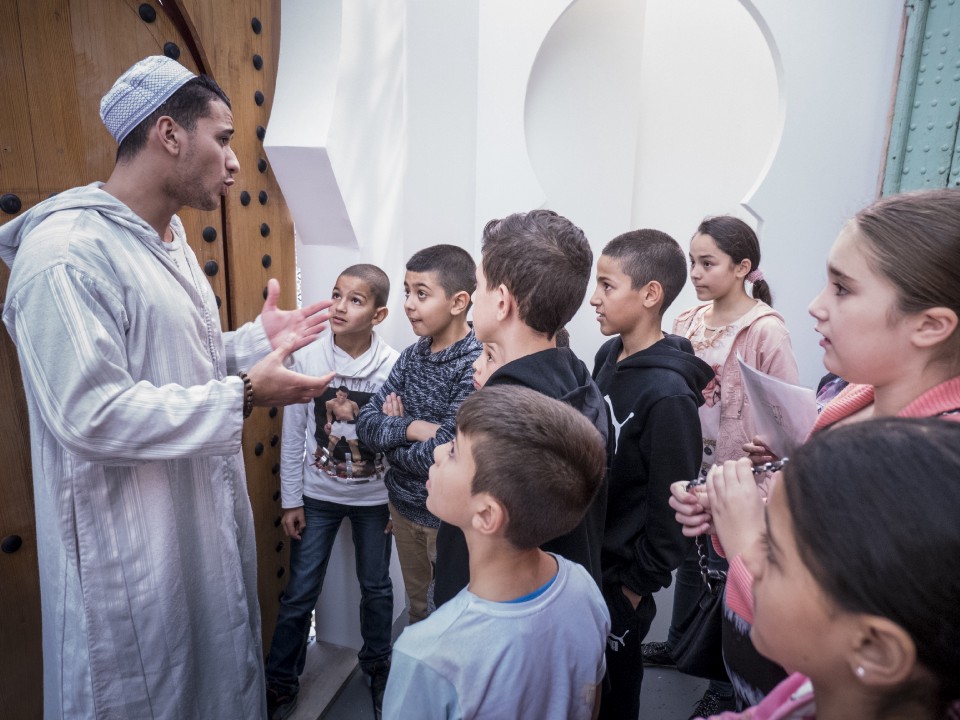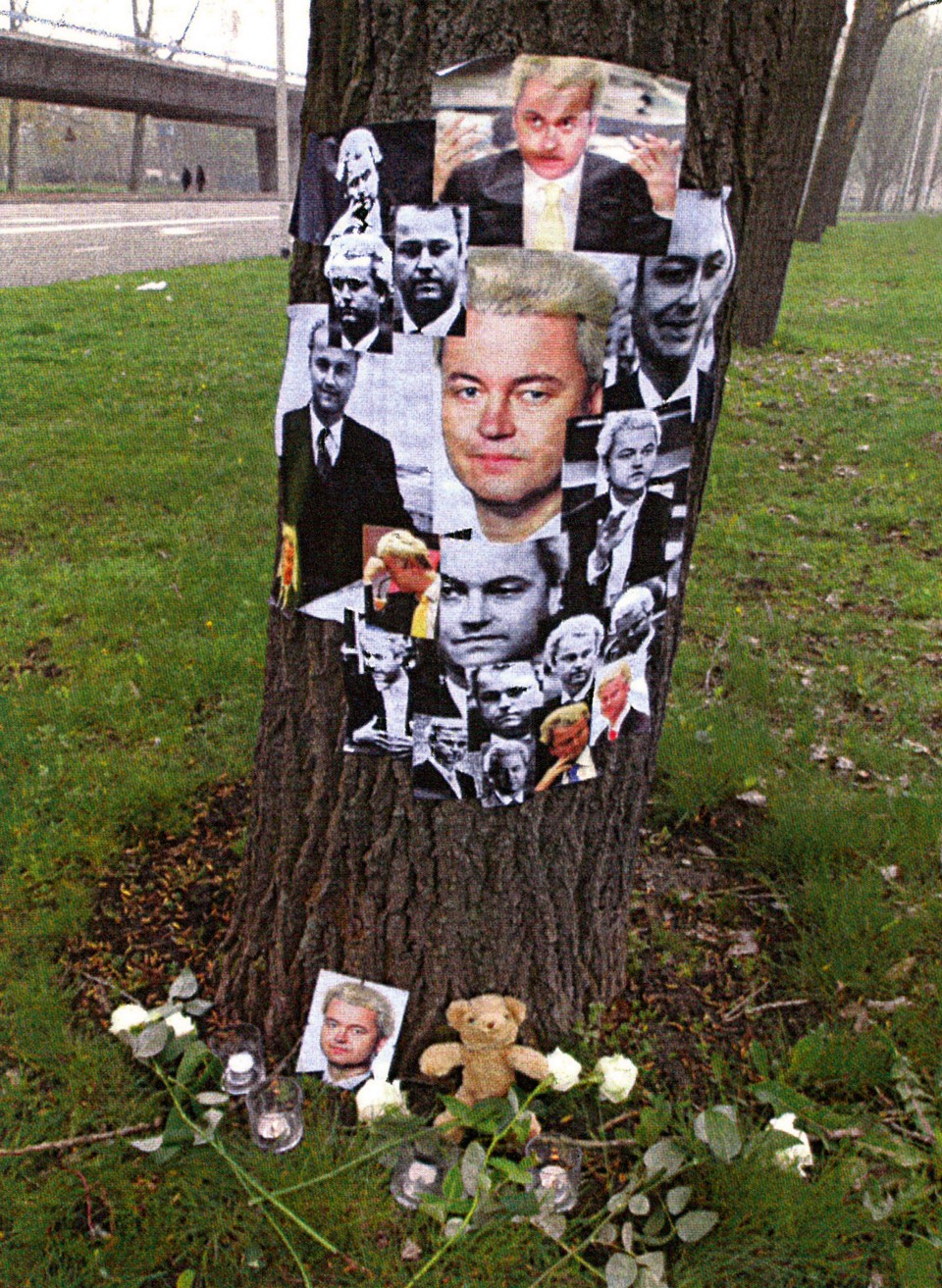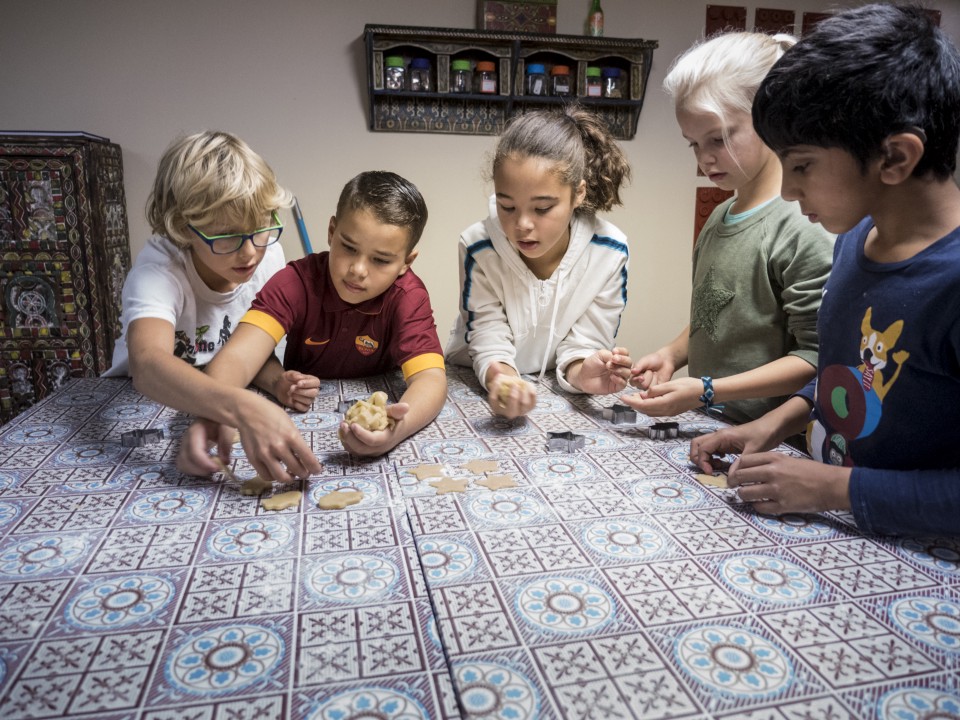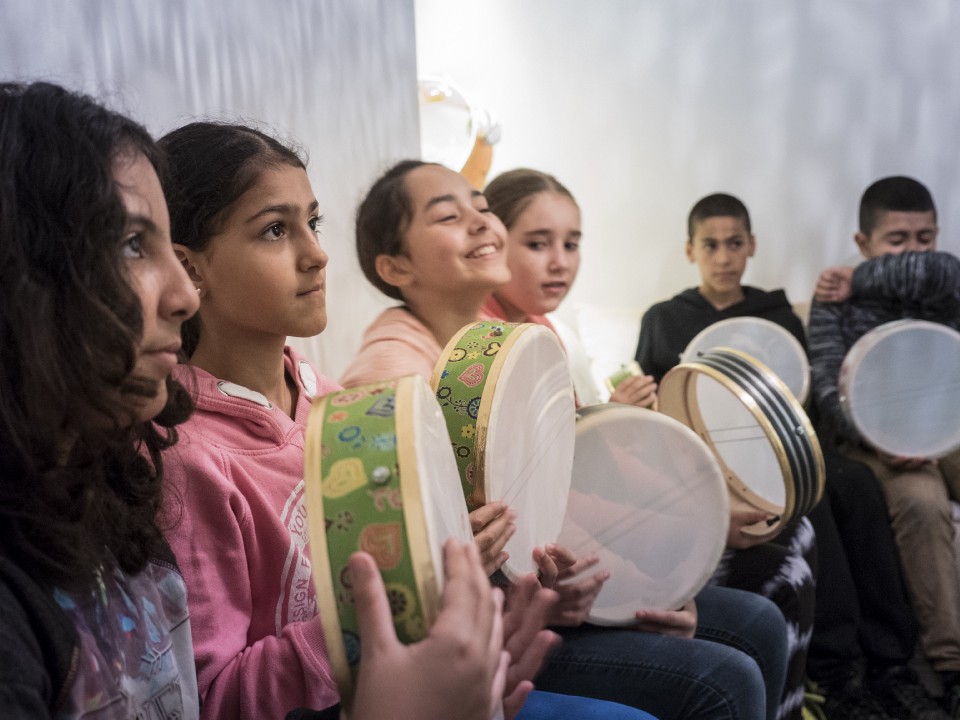As the Netherlands’ two frontrunners for prime minister make sweeping statements about immigrants, Amsterdam’s art world is calling for rhetorical nuance and empathy.
By Morgan Meaker
Children lie on tiles that were shipped from Morocco for Tropenmuseum Junior’s ZieZo Marokko exhibition. (Photo: Ivar Pel/Tropenmuseum)
Dutch children sit glued to the windows of a bus, watching street scenes from Morocco slide past. Between glimpses of meat markets and the Atlas Mountains, there is a flash of familiarity. “McDonald’s!” several shriek, pointing and bouncing on their chairs. Among the children is a boy whose family is from Marrakech: “As we’re in Morocco, we can speak like we’re at home,” he says to his friend, and their conversation slips into Arabic.
But the children are not in Morocco — they’re in a bus-simulator in Amsterdam’s Tropenmuseum Junior, the oldest children’s museum in the Netherlands. The immersive exhibition “ZieZo Marokko” — in English: “Find Your Own Way to See Morocco” — takes school groups and families into a re-created Moroccan town with narrow alleyways, a traditional courtyard, and an Islamic call to prayer, which sings out at regular intervals. They learn about the country through the stories of four Moroccan-Dutch men and women, who tell personal stories about their roots in audio exhibits.
The exhibition’s timing — it runs from October of 2015 until 2018, overlapping with the country’s general election campaigns, which culminate in today’s election — is no coincidence, says Liesbet Ruben, one of the museum’s three senior researchers. “We wanted to do something against group stereotyping; we focused on Moroccan-Dutch because they are really an issue in Holland.”

One of the exhibition’s Moroccan-Dutch tour guides talks to visiting children. (Photo: Ivar Pel/Tropenmuseum)
The Netherlands’ Moroccan population has indeed become a campaign issue for the country’s two prime minister frontrunners, Geert Wilders and incumbent Mark Rutte. Wilders, leader of the far-right Party for Freedom (PVV), which is shifting between first and second place in the polls, has called the Netherland’s Moroccan population “scum” and led chants for “fewer, fewer” Moroccans at a local election rally. (When Wilders talks about “Moroccans,” he means migrants who came as guest-workers in the 1960s and their children and grandchildren, many born in the Netherlands —in addition to the country’s estimated 167,000 Moroccan-born residents.) If Wilders is elected, the far-right leader has said he will stop immigration from Muslim countries, close all mosques, and ban the Quran.
Threatened by the PVV’s popularity, current Dutch Prime Minister Mark Rutte’s People’s Party for Freedom and Democracy has also adopted hostile rhetoric toward migrants and their descendants: In January Rutte wrote an open letter to “those people who refuse to adapt” that was spread on social media and published as a newspaper advertisement, telling his target readers to “Act normal, or go away.”
Tropenmuseum Junior is fighting back against this discriminatory rhetoric by depicting its four main Moroccan-Dutch characters as individuals, rather than as “Muslims,” “migrants,” or “foreigners” — labels given to them by the right-wing and the Dutch media. As anti-Muslim language leaks into mainstream politics, the museum is not alone in its effort to provide an alternative perspective to campaign talk. This year, several Dutch artists are countering Wilders’ and Rutte’s rhetoric by celebratingthe country’s diversity.

The Geert Wilders Works by Jonas Staal, 2005–08. (Photo: Jonas Staal)
Dutch art has countered Wilders’ anti-Islam message for nearly as long as the populist party leader has been in politics. In 2005, Jonas Staal created a series of roadside monuments where he displayed the politician’s photograph alongside flowers, candles, and teddy bears, as if he had been in a traffic accident, to highlight Wilders’ “racist politics.” (The artist says Wilders, who lives under police protection and says he receives Islamist death threats, gains support for his “public martyrdom.”) In 2009, Turkish-Dutch artist Nilgün Yerli sent Wilders flowers and love letters from Muslim students. One year later, Rotterdam’s Al-Wahda youth mosque choir released a music video that stated that wearing a headscarf is a woman’s choice — a rebuttal to Wilders’ proposed “head rag tax” the previous year.
Staal still believes that Dutch artists can help the country’s diverse communities understand each other. “If we want to break through the ‘us and them’ division bred by the war on terror and the ultra-nationalists, then art can have a role imagining who ‘us’ should be,” he says, speaking over Skype from Rotterdam. “What is the community that we’re actually part of?”

The Geert Wilders Works by Jonas Staal, 2005–08. (Photo: Jonas Staal)
At the Tropenmuseum, as children drink tea with one of the exhibition’s 13 Moroccan-Dutch tour guides, they come face-to-face with a positive image of Dutch diversity. Meanwhile, Ruben — tall and upright — says the museum is now “even more important because of increasing populism.” She continues: “On social media, people are sharing their opinions on politics without background knowledge. We want to give them that background knowledge.”
Indeed, as populist Wilders takes advantage of social media and occasionally spreads inaccurate claims on his feeds, the Dutch arts and culture community are turning to documentary techniques to educate the public and analyze political rhetoric, says Joes Segal, Dutch author and curator at Los Angeles’ Wende Museum. “It used to be the situation during all art history that politicians were fact-based and artists lived in fantasy,” Segal says. “Now it seems to be the other way around. Politicians, especially right-wing politicians, thrive on fantasy. Maybe the new artistic avant-garde is to thrive on facts.”

Visitors take part in one of Tropenmuseum Junior’s interactive activities. (Photo: Ivar Pel/Tropenmuseum)
Five kilometers from the Tropenmuseum, across the maze of waterways in Amsterdam’s canal belt, the artists represented in the Galerie Fons Welters’ recent exhibit Where Do We Go From Here? attempt to restore nuance to sweeping political speech. The exhibit, a collaboration between six Amsterdam art galleries, considers the impact of language “in these unusual times [when] a venomous type of rhetoric seems to be giving rise to the ‘freedom’ to say things previously deemed ‘unutterable,’” curator Alessandro Vincentelli wrote of the show’s concept on the gallery’s website.
“Careless speech has rarely had such disturbing consequences,” Vincentelli adds. “The recent U.S. presidential election, the British Brexit vote, the upcoming Dutch national elections — what better time to question the role of speech?”
In one of the exhibit’s six galleries, neon letters by the Israeli artist Yael Bartana shine red into a white room. The words, “We shall be strong in our weakness,” were originally created to refer to Jewish unity in the aftermath of the second World War. But the Amsterdam show encourages Bartana’s work to be re-interpreted by a Dutch audience confronted with anti-Islam political platforms. “My recent works are not just stories about two nations — Poles and Jews,” Bartana has said. “This is a universal presentation of the impossibility of living together.”
The Netherlands’ Moroccan community has experienced the consequences of what curator Vincentelli calls “poisonous” political language. Research by Ineke van der Valk of Amsterdam University, due to be released later this month, show attacks on mosques are rising. In 2015 the Dutch Complaints Bureau for Discrimination on the Internet reported a 51 percent rise in discrimination of Muslims online between 2014 and 2015.

Tropenmuseum Junior visitors make music. (Photo: Ivar Pel/Tropenmuseum)
Vincentelli believes artists are important because they can talk about politics with nuance. “They aresophisticated in their language,” he says. “But what we’ve seen in the last few months is an obliteration of sophistication. You need artists and intellectual discussion to remind you there are different ways of doing things.”
Otto Berchem, one of the 25 artists on display in Where Do We Go From Here?, tries to bring a historical perspective to the current political debate. Berchem’s work, “Impenetrable (Europa),” is a series of eight flags, each representing a leftist, terrorist group from ’70s Europe. He includes Germany’s Red Army Faction and Belgium’s Communist Combatant Cells. The artist reinvents the flags of each guerrilla movement, changing their colors and symbols until they are meaningless.
“I think that it’s worth taking a moment to step back from all the coded and un-coded fear mongering that’s being ginned up by politicians such as Wilders, [Marine] Le Pen, and Trump, and note that, not so long ago, the terrorists in Europe were Europeans,” Berchem says.
Back in the 1970s, many Moroccans say they felt welcome in the Netherlands. But the 9/11 attacks in New York and the following “war-on-terror” sparked a global shift in perceptions. Dutch society — despite its liberal reputation — was not immune.
The Dutch public will decide on Wednesday if it wants to back Geert Wilders and his PVV party. But to visit the galleries in Amsterdam, it seems the art world has already decided: The PVV’s brand of discriminatory populism doesn’t reflect its values.





